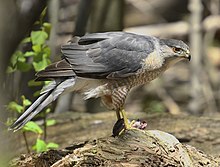The fauna of Toronto include a variety of different species situated within the city limits. Toronto contains a mosaic of ecosystems that includes forests, rivers, streams, and wetlands, which allows it to support a large variety of fauna.[1] Approximately 87 to 90 per cent of the city's indigenous flora and fauna inhabit the city reside within the Toronto ravine system.[2][3][better source needed] The city's ravine system, creeks and rivers are wildlife corridors that allow animals to travel from one area of the city to another.[4] Although most animals in Toronto reside within the ravine system, several animals also live in the city's urban environment and parks.

The City of Toronto reports there are 24 species of amphibians and reptiles, 38 species of mammals,[note 1] over 410 bird species, and a large number of insect genera in the city. There are also over 100 species of fish reported within the Greater Toronto Area.
Toronto was also in the historic range of several other animals, although the city's urban growth in the 19th century and early 20th century led to these species' natural range to recede beyond the city limits.
Vertebrates
Amphibians and reptiles


There are 24 species of amphibians and reptiles that are considered native species within the city limits of Toronto, with most populations concentrated in the wetlands found in the city.[1] Six of these native species were listed under the federal Species at Risk Act.[1] The following amphibian and reptile species (sorted by family) may be found throughout the City of Toronto:
Birds
At least 195 bird species were confirmed to breed in the area, with a total of 410 species of birds recorded in the Greater Toronto Area (either breeding, in migration, or vagrant).[1][31] A number of birds pass through the Toronto while migrating, with the city being situated around where the Atlantic and the Mississippi migratory flyways converge.
The following bird species (sorted by family) have been spotted in the City of Toronto, and Greater Toronto:[31]














- Accipitridae
- Anatidae
- Auks
- Barn-owl
- Calcariidae
- Cardinalidae
- Charadriidae
- Coots
- Cormorant
- Crane
- Crow
- Cuckoo
- Falcon
- Finch
- Gannet
- Gnatcatcher
- Grebe
- Heron
- Hummingbird
- Ibis
- Icterid
- Kingfisher
- Kinglet
- Laridae
- Lark
- Loon
- Mimid
- Motacillidae
- New World quail
- New World vulture
- New World warbler
- 52 species of New World warblers
- Nightjar
- Nuthatch
- Old World flycatcher
- Osprey
- Oystercatcher
- Pelican
- Phasianidae
- Pigeons
- Procellariidae
- Recurvirostridae
- Sandpiper
- 34 species of sandpipers
- Shrike
- Skua
- Sparrows
- 24 species of sparrows
- Starling
- Swallows
- Swift
- Thrush
- Treecreeper
- True owl
- Tyrant flycatcher
- Tit
- Vireonidae
- Seven species from the genus Vireo.
- Waxwing
- Woodpecker
- Wren
Fish
There is approximately 100 species of coldwater, coolwater, and warmwater fish found within the waterways of Greater Toronto.[1] The following fish species are found in the creeks, ponds, and rivers that make up the Toronto waterway system, and the Toronto waterfront along Lake Ontario:[33][34]
Mammals



There are 38 species of mammals that reside within Toronto, although these numbers have fluctuated due to environmental changes and loss of natural habitats during the past century.[1] The following mammals (sorted by family) may be found throughout the City of Toronto:[note 1][35]
Historic species
The historic range for several mammal species once extended into the City of Toronto. However, as the city developed, the natural range for several mammals receded beyond the city limits. At least 11 species of mammals were extirpated from the region.[1] The historic range for the following mammals once included Toronto, but were pushed beyond the city limits prior to 1912:[35]
Invertebrates

Within the city of Toronto, there exists approximately 110 species of butterflies, although this number is prone to fluctuations as a result of a varied environment from year to year.[1] There is approximately six families of bees in Toronto, which includes 37 genera and 364 species of bees in Toronto.[1] Past published records estimate that there are 25 genera and approximately 200 species of spiders in Toronto; 24 of which were introduced to the region.[1] However, it is estimated that the actual number of species that exist in the city is approximately three times larger.[1] The following insects may be found throughout the City of Toronto including:[citation needed]

